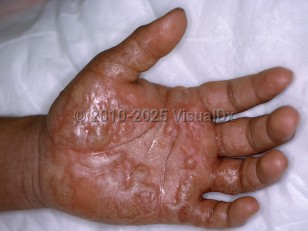Anhydrous Ammonia:
Anhydrous ammonia is a colorless, pungent gas frequently used in agriculture as well as in the manufacture of synthetic fibers. Contact with water produces ammonium hydroxide. Contact can result in multiple findings.
- Upper respiratory – Sore throat, nasal irritation with sneezing, and rhinorrhea.
- Lower respiratory – Chest tightness, coughing, wheezing, tachycardia, pulmonary edema, airway obstruction from sloughed tissue, and respiratory arrest.
- Gastrointestinal (GI) – Nausea and vomiting.
- Cutaneous – Depending on the concentration of the gas, superficial to full thickness burns with tissue loss, thrombosis, and necrosis.
- Ocular – Lacrimation, conjunctivitis, palpebral edema, blepharospasm, photophobia, ulceration, perforation, and loss of vision.
- Ammonia inhalation can be fatal. The Immediately Dangerous to Life or Health (IDLH) air concentration of ammonia is 300 ppm.
Sulfur dioxide is a compressed gas that has industrial and commercial applications. Contact with moisture produces sulfurous acid.
- Upper respiratory – Sore throat, nasal irritation with sneezing, and rhinorrhea.
- Lower respiratory – Chest tightness, coughing, wheezing, dyspnea, tachycardia, pulmonary edema, cyanosis, and airway obstruction from sloughed tissue.
- GI – Nausea with vomiting.
- Cutaneous – Chemical burns, especially in moist areas such as the axillae and groin.
- Ocular – Lacrimation, conjunctivitis, local edema, corneal damage, ulceration, perforation, and loss of sight.
- Sulfur dioxide inhalation can be lethal. The IDLH air concentration of sulfur dioxide is 100 ppm.
Hydrochloric acid (HCl) is a severe corrosive used in the production of chlorides, ore refining in tin production, and as laboratory reagent, among others uses. It is a colorless or yellowish liquid with a pungent, irritating odor.
- Respiratory – Corrosive burns, necrosis of the bronchial epithelium, constriction of the larynx and bronchi, nasoseptal perforation, and glottal closure may result from inhalation of hydrochloric acid. Prolonged exposure may cause pneumonitis and pulmonary edema.
- GI – Ingestion of liquid can result in pain, irritation, nausea, vomiting (with coffee-ground emesis), thirst, dysphagia, salivation, chills, fever, anxiety, shock, and burns, ulceration, or perforation of the GI tract. Peritonitis, strictures, and stenosis may also result.
- Cutaneous – In addition to burns, cutaneous exposure may result in irritation, pain, dermatitis, and ulceration. Frostbite can result from contact with refrigerated liquid.
- Ocular – Liquid splashed in the eye can cause permanent eye damage. Pain, swelling, conjunctivitis, corneal erosion, and necrosis of conjunctiva and corneal epithelium with perforation or scarring also may be seen.
- Death may result from circulatory shock, asphyxia, or stomach perforation.
- The IDLH air concentration for hydrochloric acid is 50 ppm.



